Here at IDKC we adhere to the same standards as ABR Register. IDKC in an officially recognized registry in association with American Bully Register.
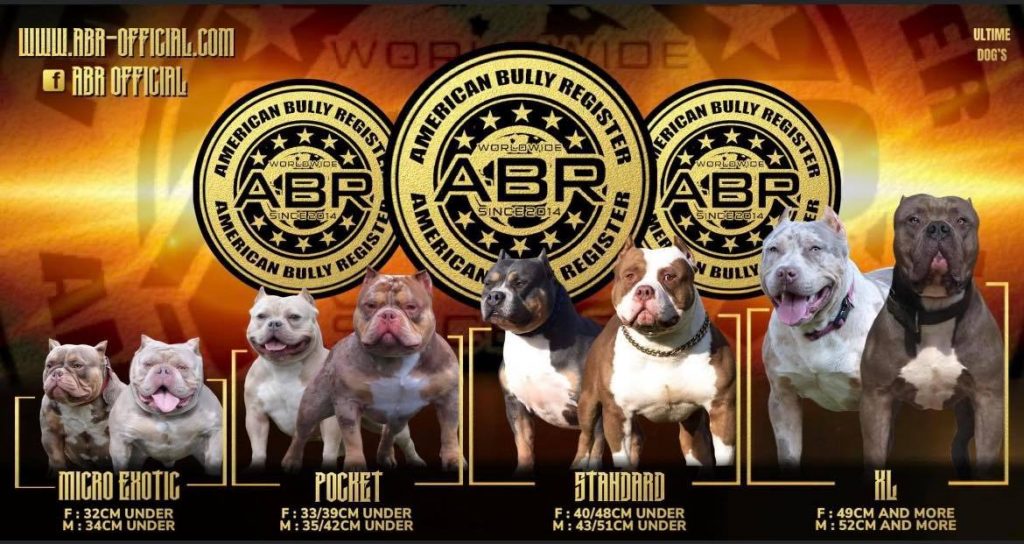
American Bully
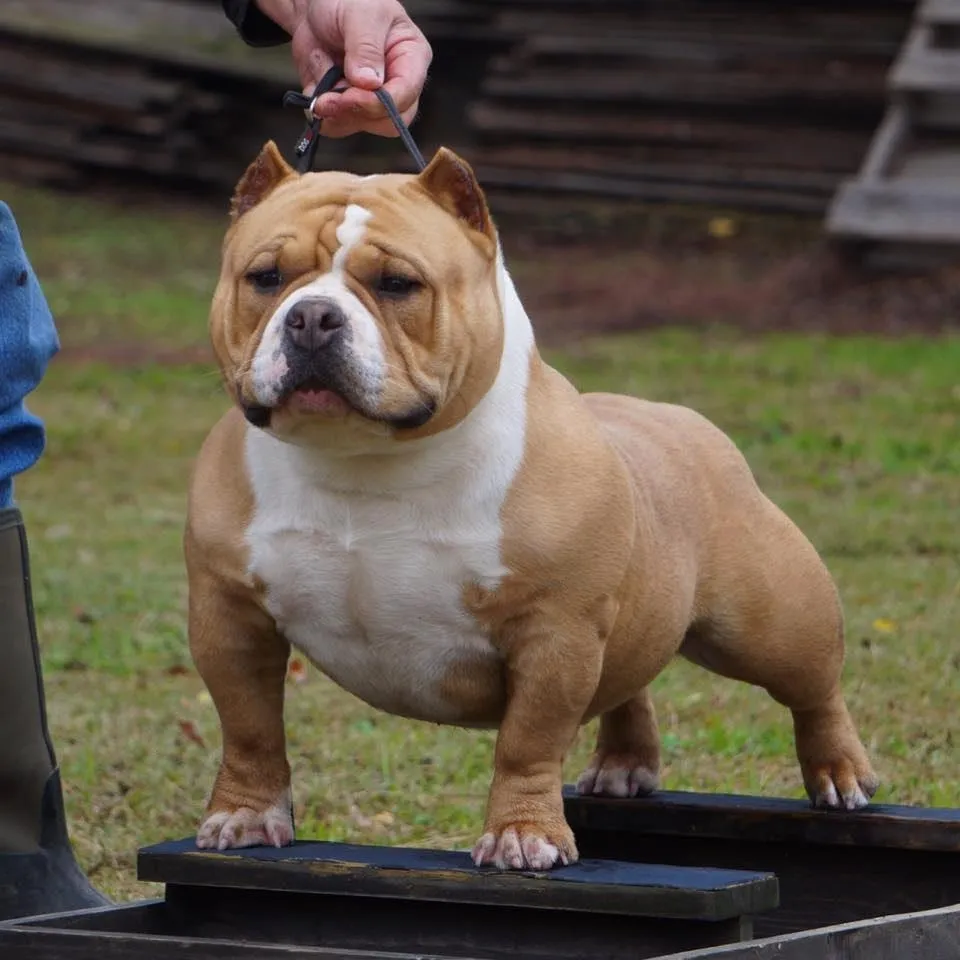

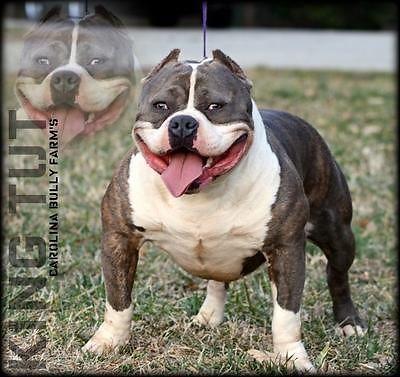
GENERAL IMPRESSION The American Bully is a compact but medium to large size dog with a substantially dense muscular body with the impression of heavy bone structure with a bulky build and a noticeably blocky head.
CHARACTERISTICS The American Bully is intense and powerful in appearance but their demeanor is more gentle with an amiable inclination to please and bond with their family, thus making the American Bully an excellent family companion. They exhibit drive but less of a working breed and favoring more of a docile companion breed. They are wilful but friendly and great with kids and other animals. Human or dog aggression, extreme shyness, or viciousness is very uncharacteristic of the American Bully and is highly undesirable.
HEAD •Distinguishably large and broad head with a circumference of 20 inch or more for males or 18″ or more for females measured at the very end of its jaw where the molars are and up over and around the top of its head exemplifies breed type of the American. •Wide skull, medium in length with distinct and very pronounced cheek muscles and a distinct and deep stop. • Ears- Set high and can be either natural or cropped. • Eyes- All colors equally accepted except albinism (pinkish to red) which is a disqualification. Blue eyes, lack of pigment around the eyes are undesirable. • Eye shape is oval to almond shape, low down in skull and set far apart. Round eyes are undesirable, and bulging or protruding eyes are a fault. • Visibility of the haw should be minimal. • Muzzle- Blocky or slightly squared to fall away abruptly below eyes and broad in width. Length to be shorter than the length of the skull. The distance from the tip of the nose to the stop should be roughly one- third of the distance from the tip of the nose to the back of the head The topline of the muzzle is to be straight with nose neither pointed nor turned up in profile. • Jaws- well defined. • Under jaw- to be board strong and parallel to muzzle, never turning upward. • Lips- semi close and even, minimal looseness accepted but not preferred.. • Upper Teeth- to meet tightly outside lower teeth in form or scissor bite. • Nose- Large with wide open nostrils. All colors/pigment acceptable except albinism (light pink in color).
NECK • Heavy, muscular, slightly arched, tapering from shoulder to back of skull.
FOREQUARTERS • Shoulders to be muscular with wide blades set wide sloping and deep. • Forelegs- straight but set wide apart, strong, muscular and stout with large bones, pasterns are strong, short and nearly erect. Feet- straight forward. Distance from the withers to the elbow is equal to the distance from the elbows to the bottom of the feet. Dogs that are slightly shorter in distance from the elbows to the bottom of the feet are acceptable but not desirable.
BODY • Immensely bulky and recognizably muscular body type of compact/medium length giving the impression of substantial power for its size. • Ribs well-rounded creating a barrel chest with all ribs close together rib cage to extend to the elbow or slightly below. • Chest- should be broad, deep, and well filled in The brisket should be capacious, muscular and very deep from the top of the shoulder to the lowest part where it joins the chest.
BACK • Fairly short to medium back, slight sloping from withers to rump or straight accepted with gentle short slope at rump to base of tail. The American Bully should give the appearance of a square body, equal in length when measured from point of shoulder to point of buttocks and from the withers to the ground.
HINDQUARTERS • Well muscled, let down at hocks, turning neither in nor out. • Muscular development, angulation and width of the hindquarters should be in balance with that of the forequarters. • When viewed from the rear legs are to be straight and parallel. • Croup should have a slight downward angle. Faults: Hocks turning in or out cow hocks sickle hocks narrow hindquarters straight or over-angulated stifle joints bowed legs. TAIL • Medium in comparison to size, low set, tapering to a fine point and extending approximately to the hock. • When relaxed tail is to be carried low. When moving tail is carried level with the topline or in a raised position when excited (challenge tail), but should never be carried curled over, breaking the plane of the back (gay tail). • Tail to be clear of any kinks, knots or any curvature.
FEET • Should be rounded and of moderate size in proportion to the dog. Compact, well arched,and tight.
COAT • Short, glossy, close, stiff to smooth to the touch. • Coat no longer than ½ inch (1 cm) in length.
COLOR AND PATTERN • All colors and patterns are permissible.
SIZE • Dogs should be healthy and should NOT reach the point where it is considered obese. •
Weight- There is no particular weight for the breed. •
Height-Please see Variety Amendments. •
All varieties to exhibit “Bully” characteristics and breed type traits as described in the American Bully Standard.
CLASSIC AMERICAN BULLY
Males 17-20 inches at the withers
Females 16-19 inches at the withers
POCKET AMERICAN BULLY
Males 17 inches or less at the withers
Females 16 inches or less at the withers
EXTREME AMERICAN BULLY
Males up to 20 inches at the withers
Females up to 19 inches at the withers
STANDARD AMERICAN BULLY
Males 17-20 inches at the withers.
Females 16-19 inches at the withers.
GAIT • The American Bully moves with a confident and proud attitude and alert to its surroundings. • Movement should be free and effortless with powerful drive off the rear without hindrance. Front reach should be moderate and in balance with the rear. • Legs turn neither in nor out, nor ever cross or interfere with each other. • Dog moving on the same plane – Each leg moving in the same plane shared with the other leg on the same side with minimal convergence. • Backline should remain level, with flexing to be very slight.
FAULTS Faults to be penalized but not disqualifications for showing are: • Both eyes not matched in color • Overly visible haw • Bulging or protruding eyes • Muzzle too long or snipey • Lack of pronounced/deep stop • Weak underjaw • Underjaw turning up • Albinism nose (light pink) • Nose turning up or pushed back • Tail too long or too short (approx. 1 inch (2.5 cm) from point of hock) • Curled tail (gay tail) • Level or flush bite • Overshot or Undershot bite
• Wry or cross bite • Neck too thin or weak • Neck too short or too long • Upright shoulders steep and forward scapula (shoulder blade) • Upper arm too short • Severe turned fronts (in or out) • Bowed front legs • Down at the pasterns (weak pasterns) • Splayed or flat feet • Long toes • Hocks turning in or out cow hocked • Long, Curly, or wavy coat • Movement: Rolling, pacing, sidewinding, hackney action, and paddling or pounding • Not moving on the same plane – legs over reaching, crossing over in front or rear, or rear legs moving too close or touching
SERIOUS FAULTS Faults to be heavily penalized but not disqualifications for showing are: • Severely overshot or undershot (1/4 inch (0.6cm)or more) • Kinked tail • Twisted tail • Knotted tail • Fused tail • Overly Short tail • Long coat
DISQUALIFICATIONS • Displaying or possessing aggressive behavior towards humans • Pink or Albino eyes • Unilateral or bilateral cryptorchidism (missing one or both testicles) • Unilateral or bilateral deafness (deafness in one or both ears) • Screwed tail • Bobbed tail • Docked tail
Exotic Bully
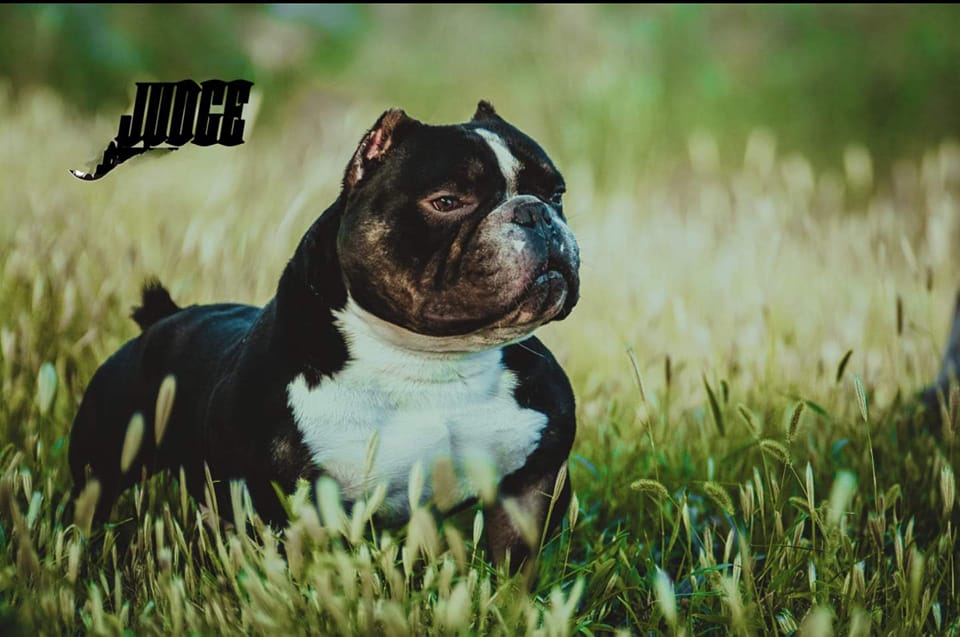
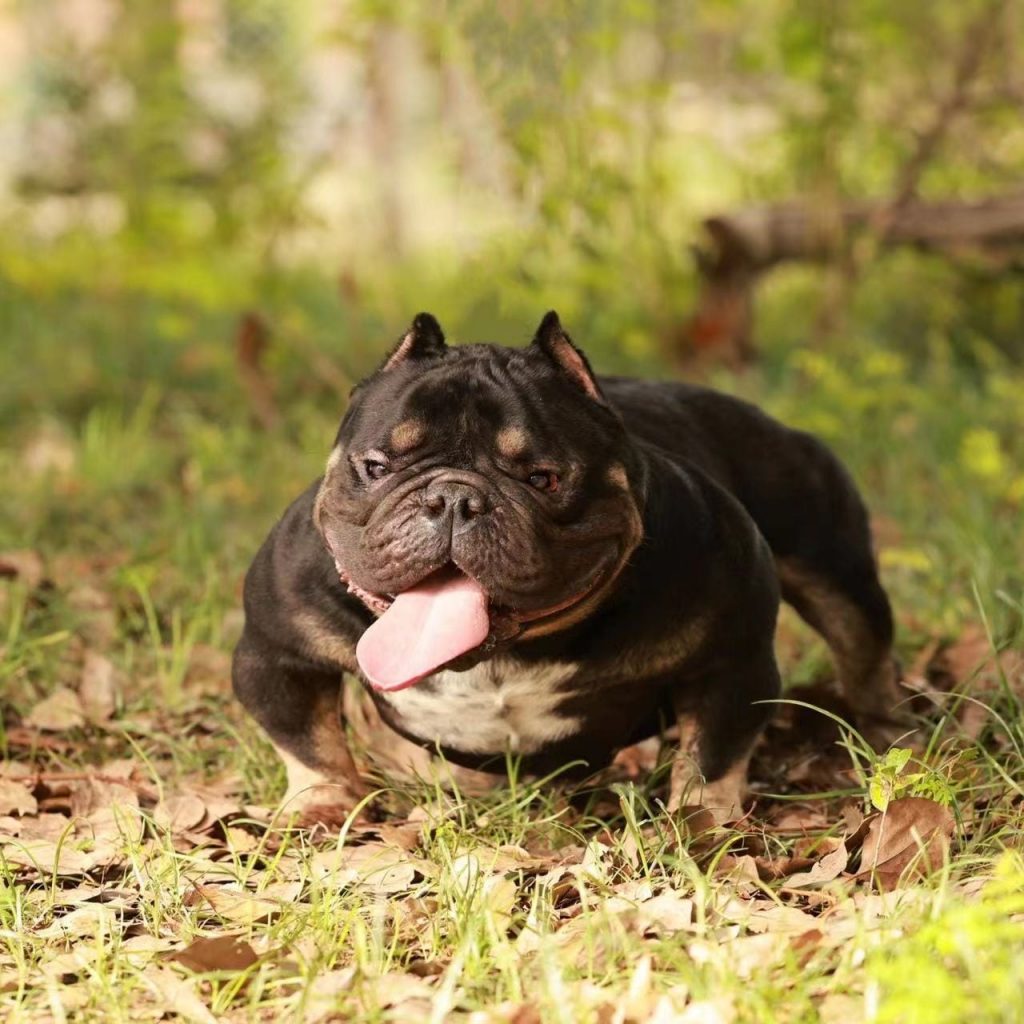
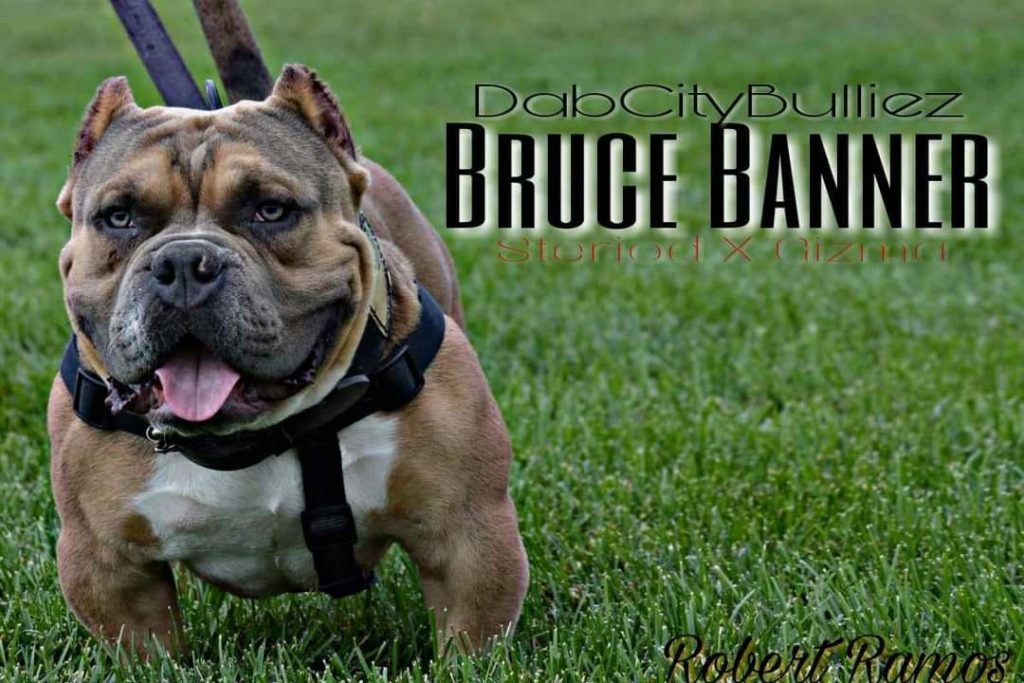
GENERAL IMPRESSION:
The Exotic Bully is a compact, medium sized dog with a smooth, short coat. It’s tight skin is stretched over a substantially dense muscular body on a heavy boned frame. Distinguishing features are its wide chest, clearly defined, muscular shoulders and rear, blocky head, pronounced cheeks and deep intentions under eyes. It’s intense expression and bulky, muscular build give the Exotic Bully a very powerful and strong appearance. This breed is docile in temperament, gentle with children, other dogs and small animals. It bonds strongly with its leader, making the Exotic Bully an excellent family companion. Aggression, viciousness or shyness is highly undesirable and very uncharacteristic for this breed.
SIZE:
MICRO EXOTIC BULLY:
13″ and under at the withers.
STANDARD EXOTIC BULLY: 13″ – 16″ at withers.
WEIGHT: In proportion to height.
HEAD: Large , broad head in proportion to body. Topskulls is prominent with stop being nearly a 90 degree angle to muzzle which is short, broad and squarely formed, coming directly out of the face with the front of the muzzle being square to ever so slightly turned up when viewed from the side but must be more straight than curved with only minimal layback of nose. Muzzle is one fourth or shorter than length of skull from mastoid process to nose. Jaws are well defined and cheeks pronounced when viewed from front and side, leaving v-shaped indentations below each eye.
EARS: Rose ears set high on head either natural or cropped.
EYES: Oval shaped set low down in skull and far apart. Round eyes are undesirable. Any color with the exception of pink or red eyes or any form of albinism. Blue eyes are acceptable but undesirable. Eyes that buldge or protrude from the skull or eyes of differing color are a fault.
BITE: can be undershot or scissor but not more than 1/4″
NECK: Heavy, muscular, short and arched.
FOREQUARTERS: Muscular and defined with visibly defined muscle group in shoulders. Forelegs short and sturdy with slight curve or bow to forelegs when viewed from front. Pasterns are upright with feet pointing directly forward. Feet should be tight, knuckled up and pointing forward and in proportion to body.
BODY: Bulky and muscular with a well rounded rib cage, wide chest that is let down to at least the elbow. The topline is level or sloping slightly downward from withers to rump. The ideal Exotic Bully should appear short and square but when measured back will be slightly longer than measurement from withers to ground.
HINDQUARTERS: Well muscled, let down at hicks, turning neither in nor out. Rear is balanced with shoulders in width. Croup slopes slightly down to tail. Angulation of stifle is moderate.
TAIL: Low set tail free of kinks, knots or curves, extending to the hock and tapering to a fine point.
COAT: Short, tight and glossy. All hair less than 1/2″ in length.
COLOR AND PATTERN: All colors and patterns are permissible.
GAIT: Given its bulky body style, the movement of the ideal Exotic Bully is somewhat restricted , limited in its action whereas it moves with short quick steps and rear feet skim the ground. This is not an endurance breed but a breed with short, powerful bursts of activity.
FAULTS:
Minor: Lack of pigment around eyes, lips or nose. Pendulant flees. Excessive wrinkle. Screwed, short , or docked tail. Wry Jaw
Major: Excessive amount of haw showing. Long or snipey muzzle. Weak underjaw. Long neck. Severely turned out front feet. Severely bowed out front legs. Down pasterns. Splayed feet. Severe cow hocks. Straight stifles. Sway back. Excessively high rear. Eyes not of same color.
DISQUALIFICATIONS: Albino dogs. Curly, fuzzy, long or wavy hair., Cryptorchidism (one testicle).
THE EXOTIC BULLY SHOULD NOT RESEMBLE AN AMERICAN BULLY AND IS NOT A FAULTED AMERICAN BULLY!
XL Bully
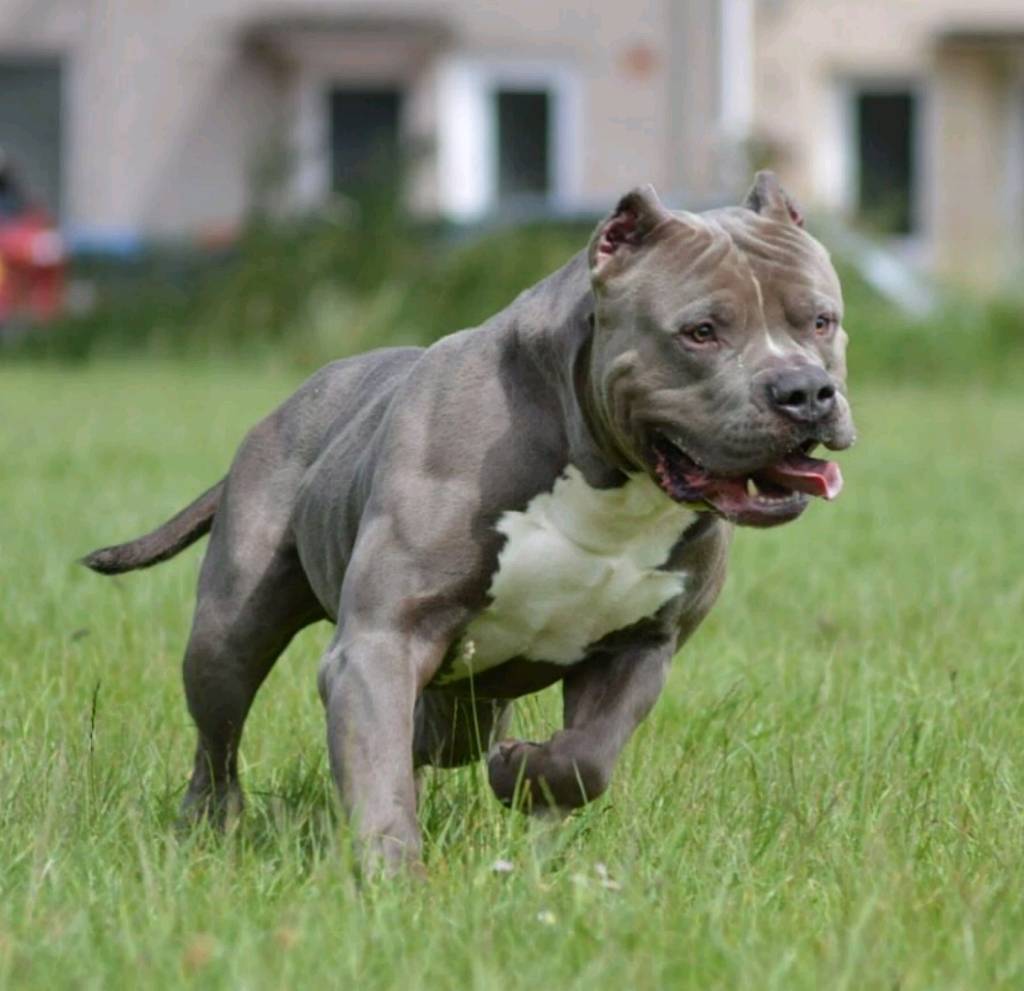
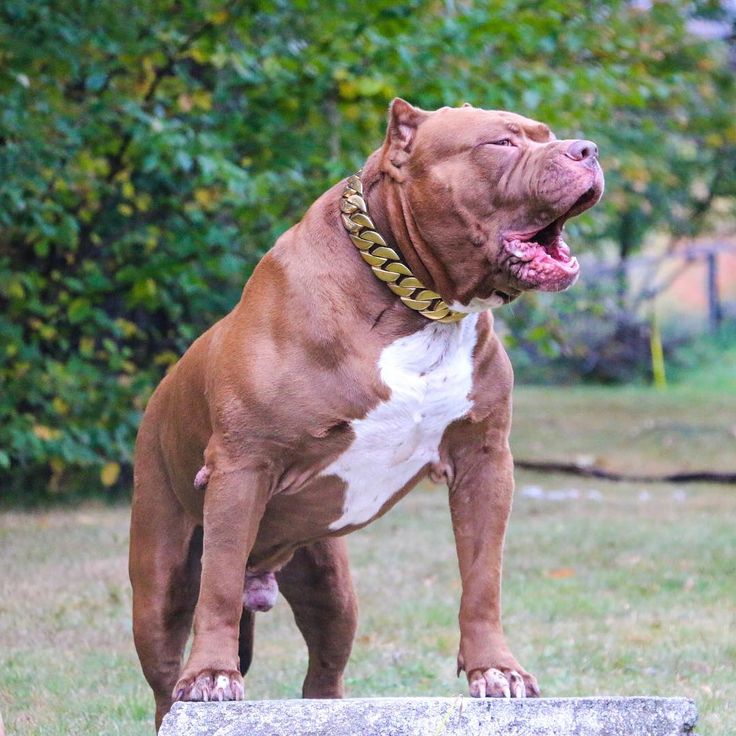
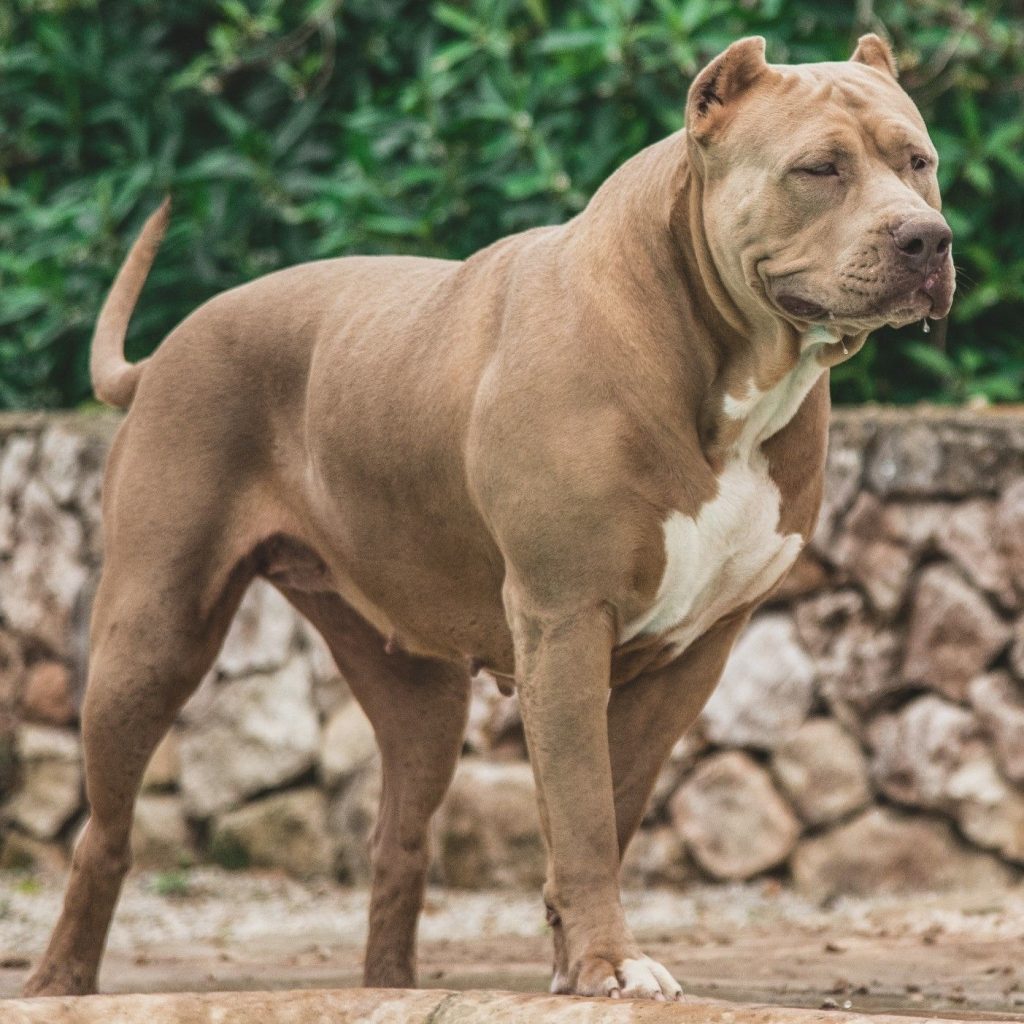
THE XL BULLY IS AN AMERICAN BULLY THAT IS
MALES: 20″ or more at the withers
FEMALES: 19″ or more at the withers
THERE IS NO MAXIMUM HEIGHT OR WEIGHT
French Bulldog
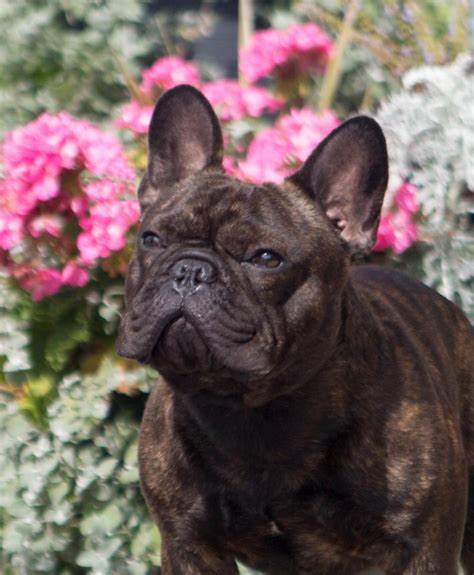
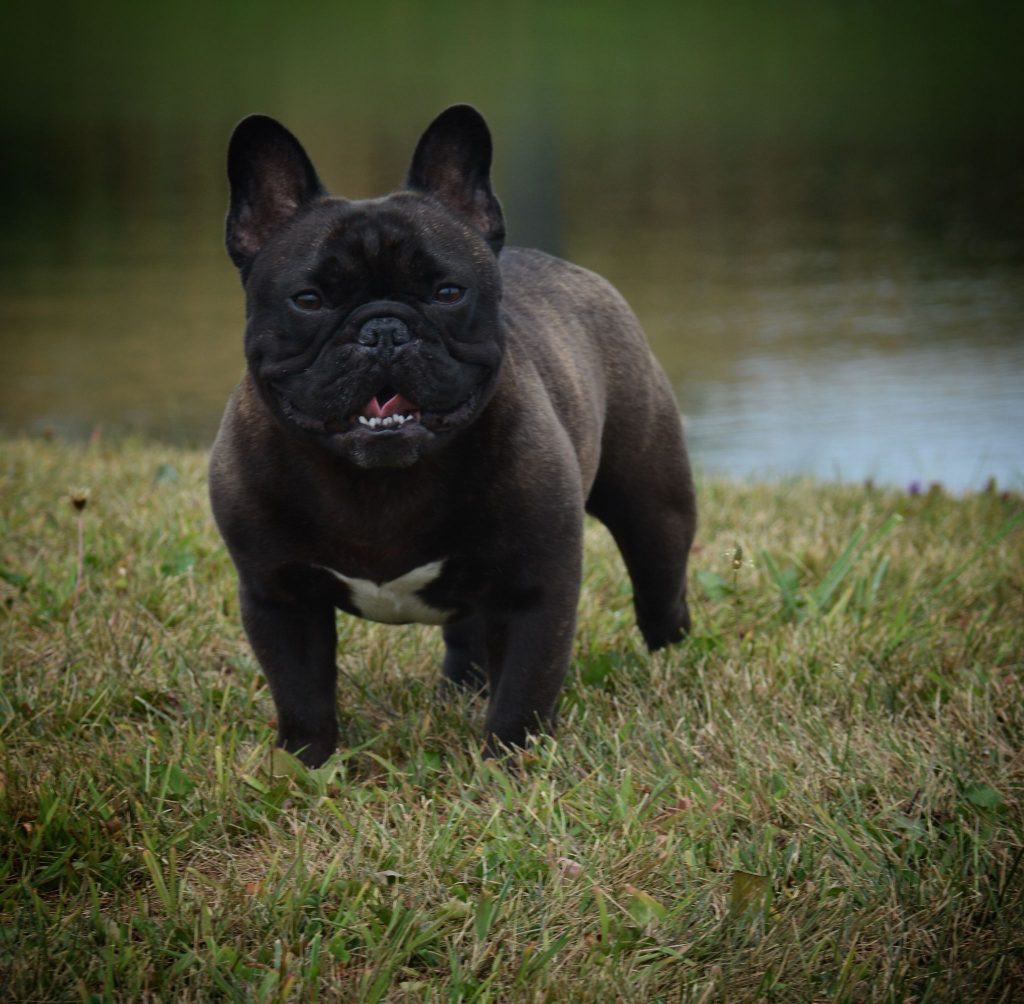
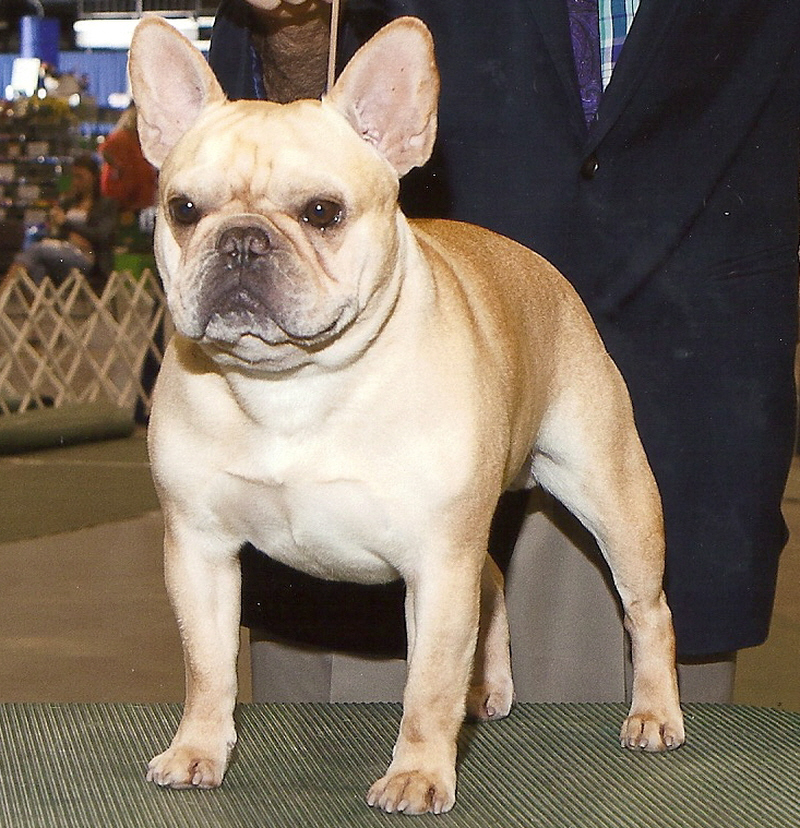
The AKC states that the French Bulldog should have the appearance of an active, intelligent, muscular dog of heavy bone, smooth coat, compact build, and medium to small structure, that is well proportioned. It’s expression is alert, curious, and interested.
French Bulldogs are fairly small – 28 pounds or less, so they can function as lap dogs. They have a bully head which is large and square – generally being more pronounced in males than in females.
Their two most noted features are (1) their characteristic bat-ears, which are broad at the base, elongated, with round top, set high on the head but not too close together, and carried erect with the orifice to the front, and (2) their short tail which is either straight or screwed.
The neck is thick and well arched with loose skin at the throat.
The body is short and well rounded.
The chest is broad, deep, and full; well ribbed with the belly tucked up.
The forelegs are short, stout, straight, muscular, and wide apart.
The hind legs are strong and muscular and longer than the forelegs, so as to elevate the loins above the shoulders.
The coat is moderately fine, brilliant, short, and smooth.
The skin is soft and loose, especially at the head and shoulders, forming wrinkles. Piedness is a recessive characteristic in French Bulldogs but is still relatively common (two pied dogs will produce only pied puppies, two pied carriers will produce 25% pied puppies, etc). A pied Frenchie is one that has a base coat of white with patches of a darker color which is brindled. Pied is a pattern and not a specific color but can come in all shades of standard colors. Standard colors are fawn, creme, red, white, and brindle (dark coloring with lighter hairs mixed in or the reverse) and are all acceptable colors in the AKC show ring.
There are quite a variety of colors and patterns, which make them all so unique and special even among their own breed. Whatever your particular preference, we are sure to eventually have the dog for you in one of our breedings.
Temperament:
The AKC describes their temperament as well behaved, adaptable, and comfortable companions with an affectionate nature and even disposition; generally active, alert, and playful, but not boisterous. Frenchies absolutely love people and crave attention, but don’t constantly demand it. A French Bulldog will comfortably sit or lay at your feet, or in your lap if you prefer, or they will roll around with the little ones with great patience and never complain.
Fluffy French Bulldog

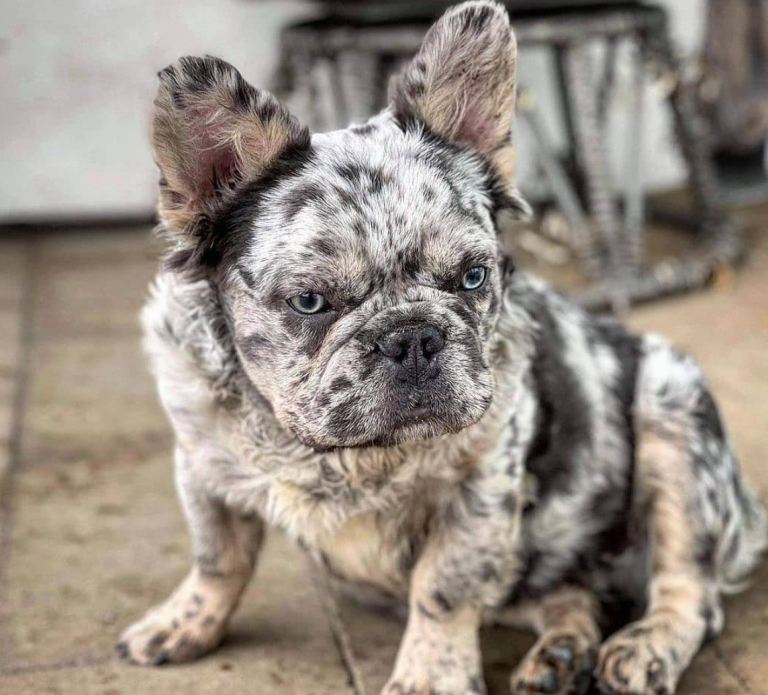
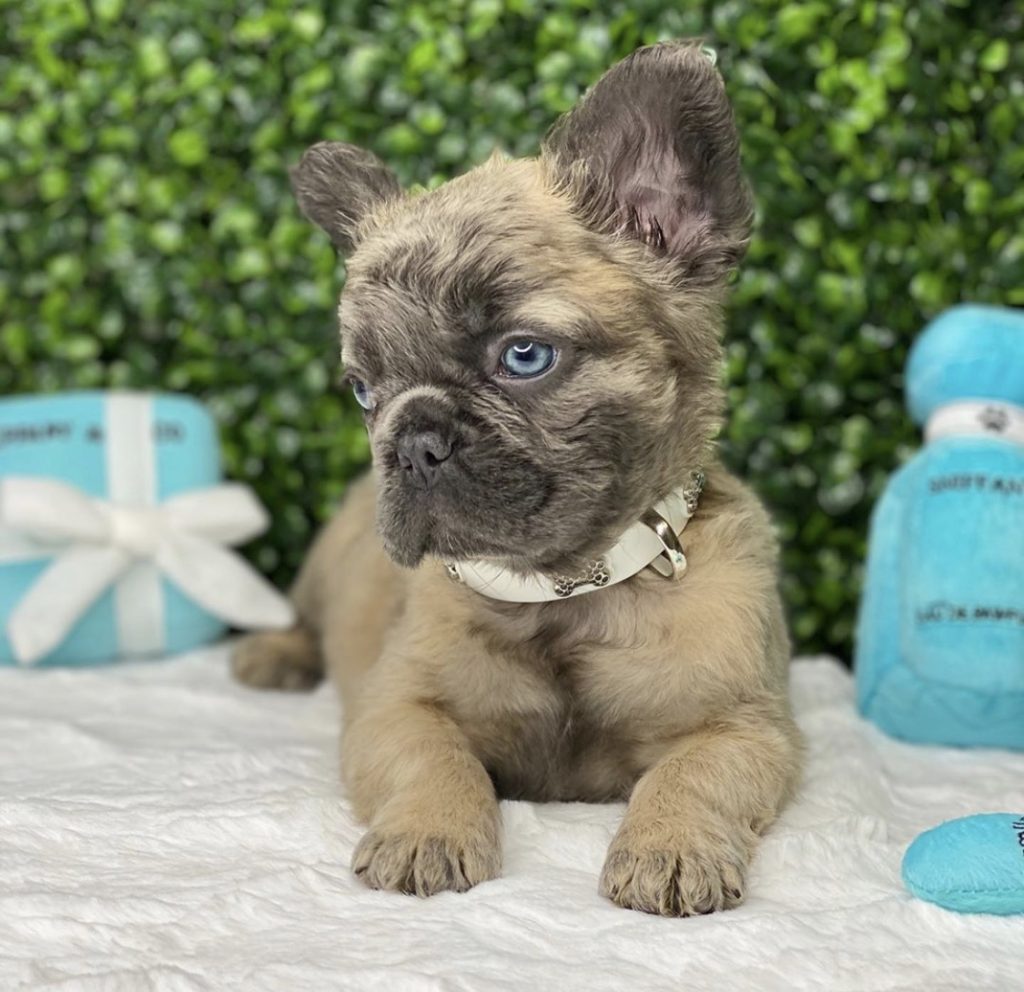
OFFICIAL BREED STANDARD COMING SOON
English Bulldog
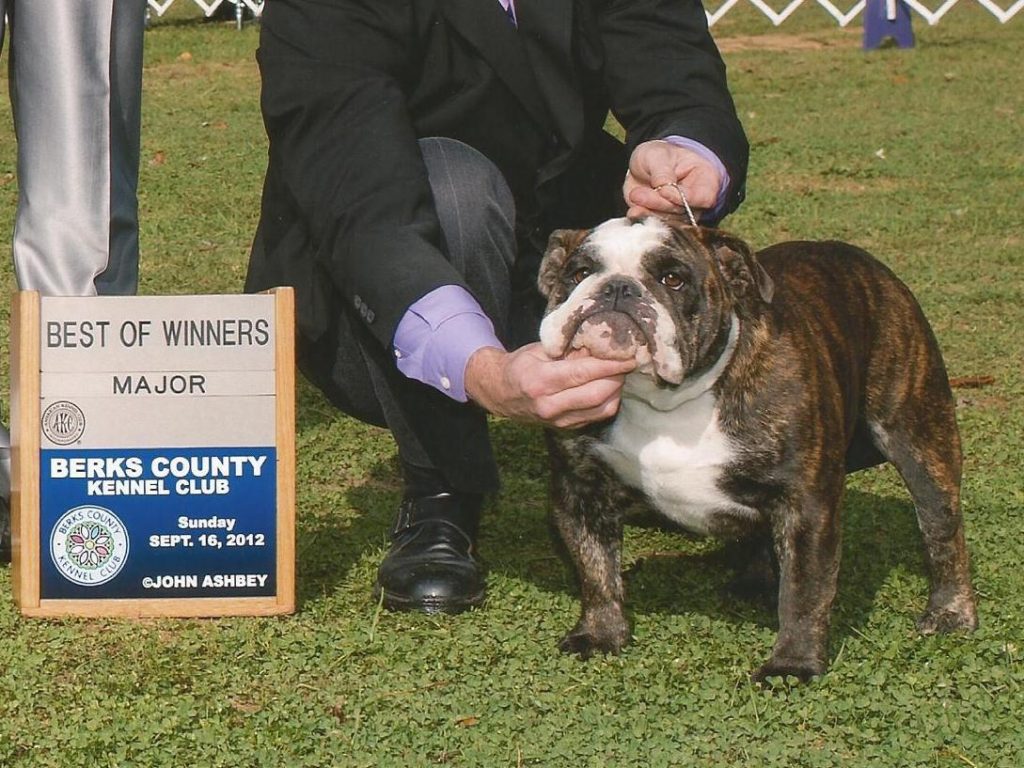
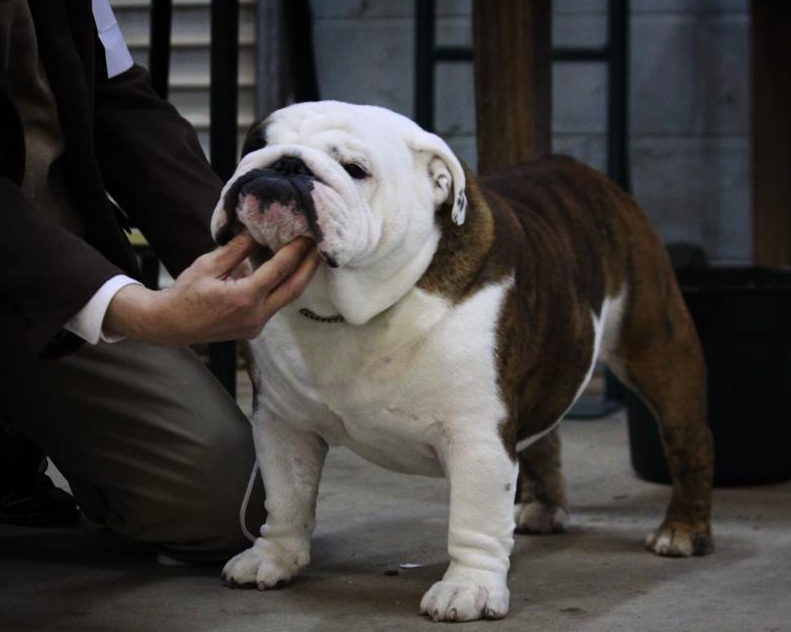
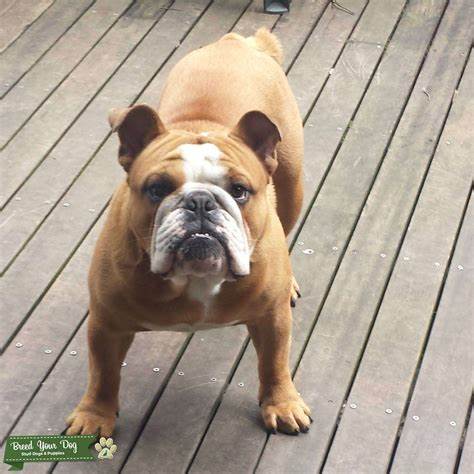
Head and Shoulder Standards
The English bulldog is bred to have wide shoulders as well as a wide head. The shoulders should have a lot of loose folds of skin. The ears are set far back on the skull and ideally should have folds that show the undersides of the ears as they curl forward over the wrinkled forehead. The big head needs to be at least as large in circumference as the length of the forelegs to the shoulder.
Face and Neck Standards
A champion English bulldog has a lower jaw that juts out further than the top jaw, creating a pronounced underbite, and there is a thick fold of skin over the dog’s short nose, known as a rope. The eyes should be positioned low on the front of the face, but far apart, and should be round in shape with dark irises. The neck is short, muscular and thick, with wrinkles and hanging dewlaps.
Back, Body and Tail Standards
The bulldog’s back should be well-rounded, with the hips widely spaced and set higher than the shoulders. The belly should be concave, and the chest rounded and well-muscled. There should be plenty of wrinkles along the length of the back, with the largest being located over the shoulder area. The short tail should ideally be set low on the rump and should be either straight or tightly coiled but not curly or long.
Forequarter Standards
The front legs should be short and only slightly bowed. The paws should either face straight forward or point slightly outward, and all of the claws should be naturally short. The legs have a lot of loose skin that resemble baggy hose, and the toes should be proportioned to the size of the forelegs, and not too large or too small. The chest should be wide and round, with many sagging wrinkles and two dewlaps.
Hindquarters Standards
The hind legs should be muscular, widely spaced and slightly longer than the front legs to make the hips rise above the shoulders, with the toes pointing outward. There are fewer wrinkles on the hind legs, but they are still present on the foot area, making it look like the dog’s socks have fallen down. The rump should be high, round and somewhat smoother than the rest of the animal’s skin.
Coat and Skin Standards
The coat of the English bulldog grows short, fine and close to the skin. It should be glossy in appearance. Long hair is undesirable in this breed, and so is curly hair. The most desirable coat color is red brindle, which is a brownish-red shade with darker patches mixed in. Other brindle shades are the second most desirable, followed by solid white, solid red, fawn and piebald. The skin should be soft, loose and draped in thick wrinkles. All colors permitted.
Weight and Disposition Standards
The male bulldog should weigh a solid 50 pounds, and the female should weigh 40 pounds. Bulldogs should be gentle, sweet and nonaggressive. Bulldogs are friendly and patient, and are known for getting along with children as well as other dogs or other pets. These dogs are loyal and attached to their families, usually refusing to go anywhere without their people. Bulldogs consider themselves lap dogs and are cuddly in nature.
OLDE ENGLISH BULDOGGE
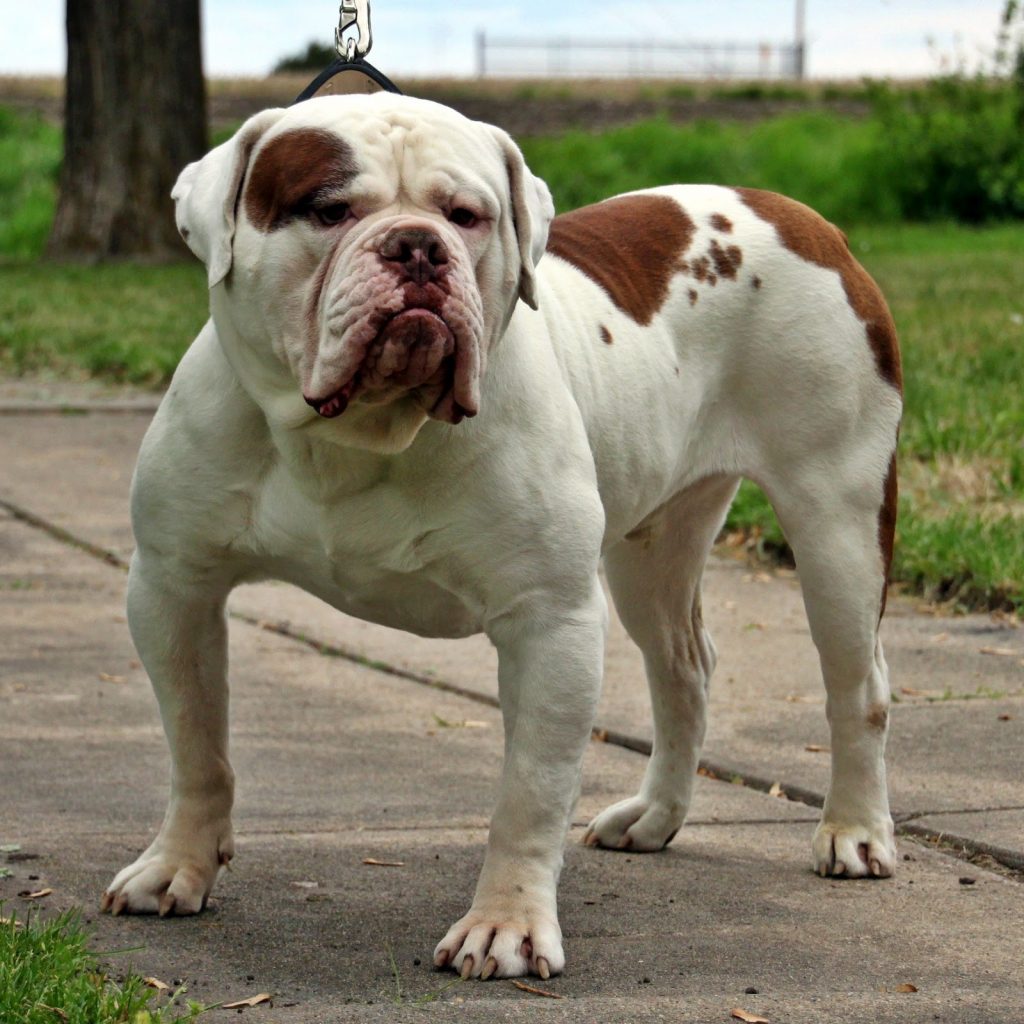
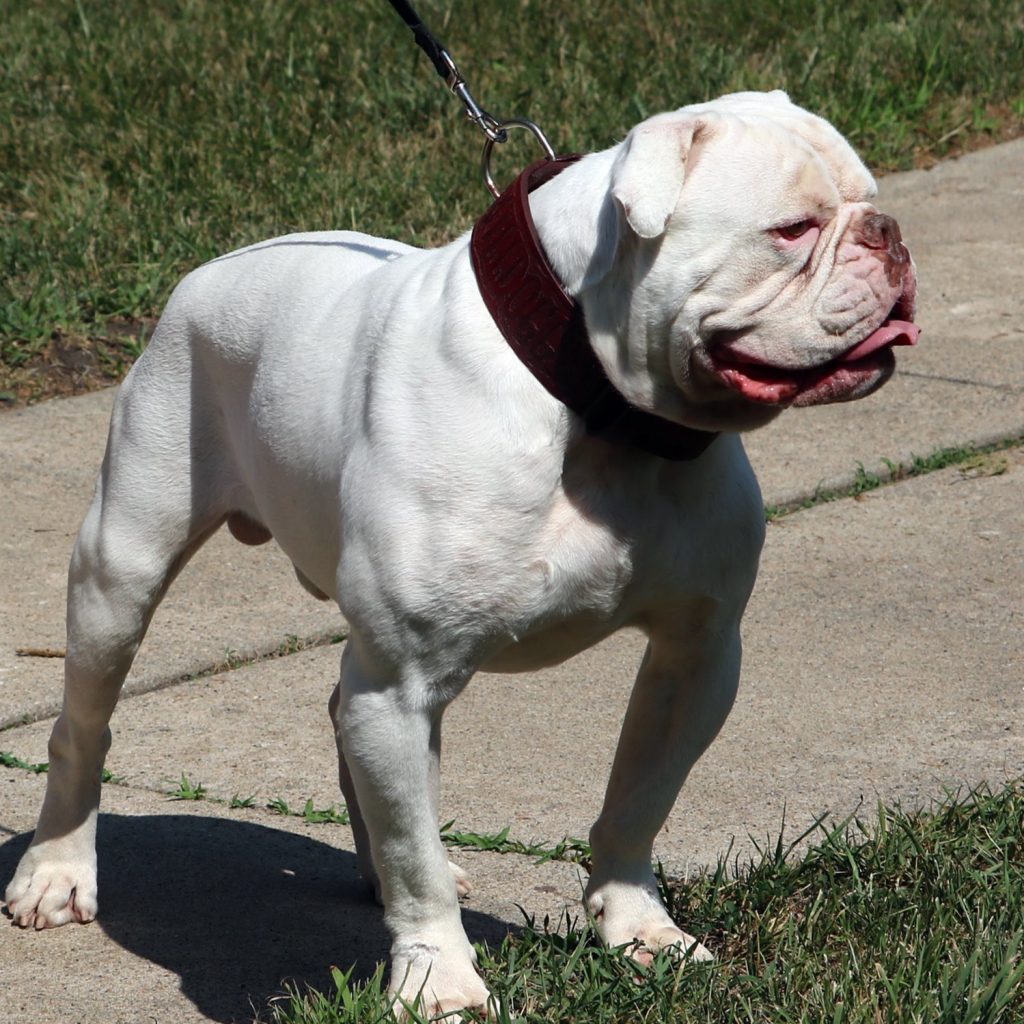
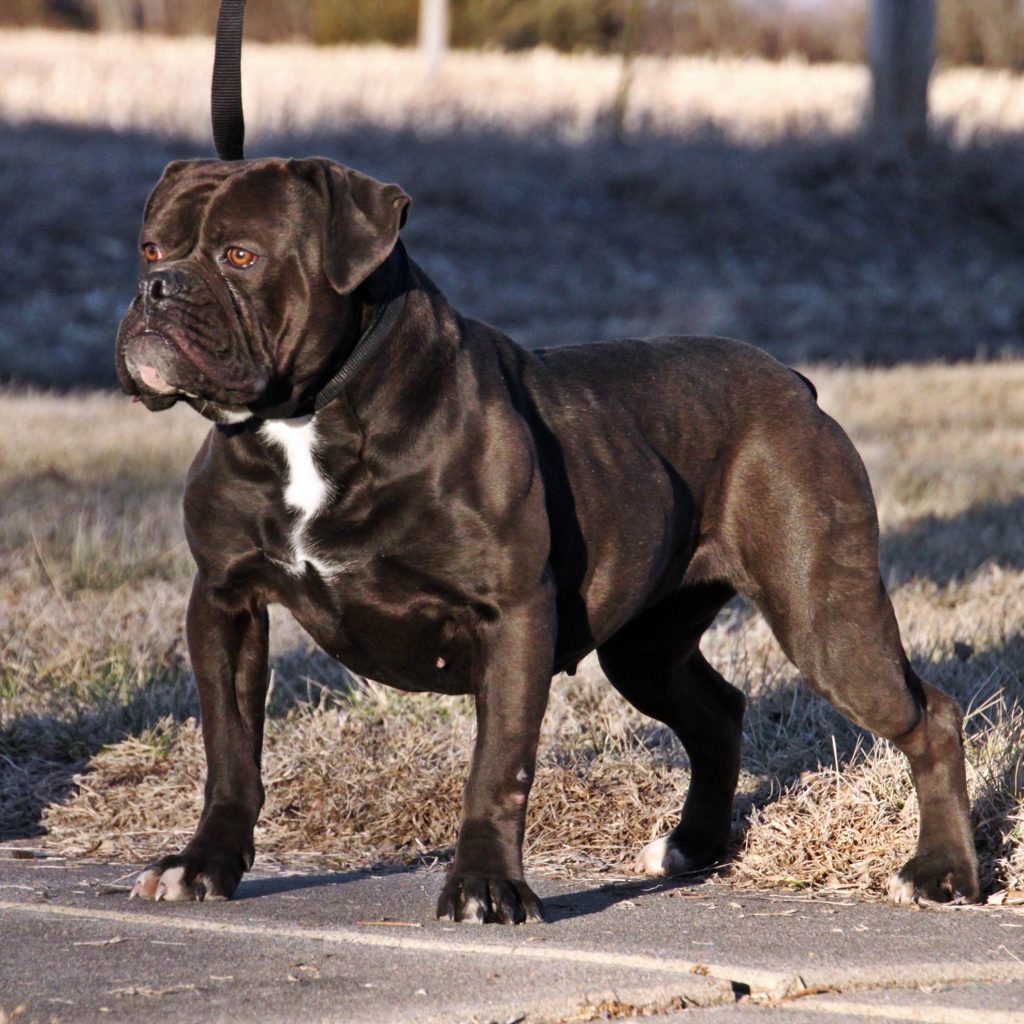
Head : Large and high, moderately sunken between the eyes (medial furrow). The circumference of the head should be equal to or greater than the dog’s height at the shoulder. A narrow head or one that appears too small for the body is a fault.
Ears : Rose ears set well on the sides of the head are preferred. Dropped ears are acceptable as long they are small, not “hound like”. Full pricked ears that stand up on top of the head should be considered a serious fault.
Muzzle : Broad, deep and short with moderate wrinkling. The bite is undershot with the bottom jaw turning up noticeably. Lower canines should not protrude. Muzzle too long (more than 3 inches), scissor bite or even bite are disqualifying faults. Muzzle should be no shorter than 1 ½”. Wry jaw is a disqualifying fault.
Eyes : Wide apart and of moderate size. Any color is acceptable. However, odd eyes (one dark, one blue or light) should be considered non preferred. Misshapen or bugged eyes are a serious fault. Lacking pigment around the eyes is undesirable. Crossed eyes or non-symmetrically shaped eyes are a disqualifying fault.
Nose : Broad with open nostrils (nares) with no sign of air restriction. The nose should not be pushed up between the eyes. From the stop to the end of the nose must be at least one and one half inches. The nose should be a solid color. Lacking pigment is a serious fault. A nose lacking all pigment is a disqualifying fault.
Neck : Short to medium in length and very muscular flowing into the shoulders and should not be set on the dog so it appears to stop at the shoulders.
Chest : Ribs should be well sprung (rounded) and the chest wide and deep. Depth of chest should be at least to the elbows. A hollow or narrow chest (slab sided) should be considered a serious fault.
Back : Males should appear square and balanced. Females should appear similar with consideration given for body length. Short with a very slight rise from the shoulders to a slight drop in the croup is preferred. A level back is acceptable as long as the tail does not come straight off the top of the back.
Shoulders : Shoulders should be well laid back with significant angulations to allow for good movement. Straight shoulders are a fault.
Legs : Forelegs should be straight and wide apart, neither bowing out nor turning in. There should be significant bone substance. Elbows should be relatively close to the body. Lacking bone and substance is very undesirable. Elbows that are loose or “fiddle fronts” are a disqualifying fault. “East / West” forelegs are a serious fault. Rear legs should exhibit significant bend of stifle so to allow for good movement. They should be well muscled. Straight or “posty” rear legs are a serious fault. Cow hocks are a disqualifying fault.
Movement : Dogs should have a balanced gait that drives off the rear and is complimented by reach allowing the dog to cover ground with a sense of power. Dogs should single track. Pacing or crabbing is a serious fault.
Feet : Round, tight both front and rear, and the pasterns should be strong. Weak pasterns and/or splayed feet are disqualifying faults.
Height : Males – 18 to 20 inches at the shoulder. Females – 17 to 19 inches at the shoulder.
Weight : Between 50 to 70 pounds for females and 65 to 85 pounds for males. Although height and weight above the standard is to be discouraged, there is no penalty as long as the dog is well proportioned, otherwise correct and balanced.
Color : Any color is acceptable with no preference of one over another.
Coat : The coat is short. A wavy coat or a long coat is a disqualifying fault; there should not be any signs of feathering on the legs, ears or neck area. OEBs with any sign of long or wavy coats are NOT to be registered.
Tail : A pump handle tail that naturally reaches the hock is preferred, screwed short or a docked tails are acceptable. The pump handle tail should be carried low and not over the back of the dog.
Temperament : Disposition should be outgoing and happy. While a watchful nature may be expected at home, human aggression without provocation is a disqualifying fault.
American Bulldog


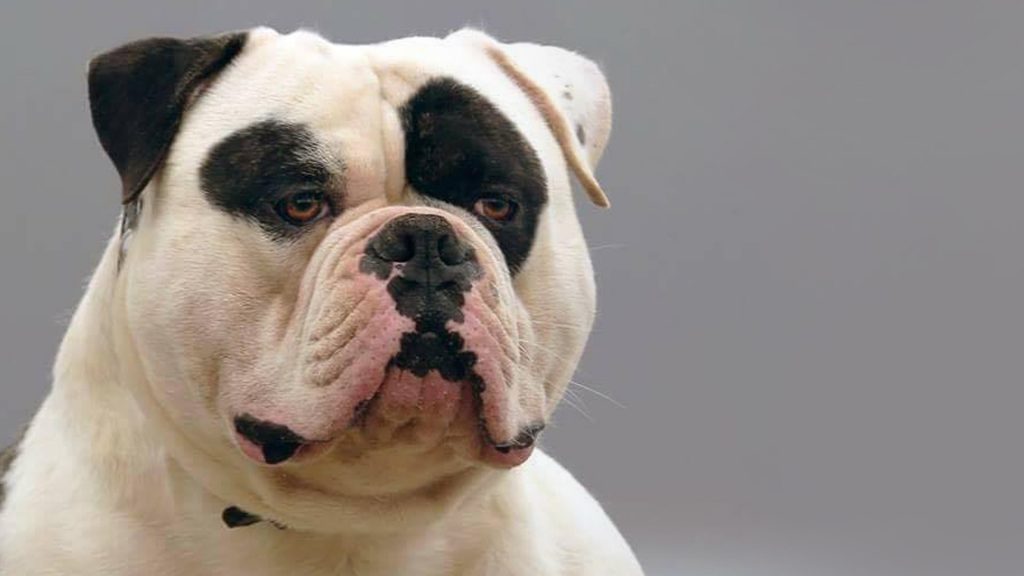
General
The American Bulldog is a powerful, athletic short-coated dog, strongly muscled, and well boned. The body is just slightly longer than tall. The head is large and broad, with a wide muzzle. Ears are small to medium in size, high set, and may be drop, semi-prick, rose, or cropped. The tail may be docked or natural. The American Bulldog comes in solid colors, white with colored patches, and brindle. Gender differences are well expressed in this breed, with males typically larger and more muscular than females. Honorable scars resulting from field work are not to be penalized. The American Bulldog should be evaluated as a working dog, and exaggerations or faults should be penalized in proportion to how much they interfere with the dog’s ability to work.
Characteristics of the Breed
The essential characteristics of the American Bulldog are those which enable it to work as a hog and cattle catching dog, and a protector of personal property. These tasks require a powerful, agile, confident dog with a large head and powerful jaws. The American Bulldog is a gentle, loving family companion who is fearless enough to face an angry bull or a human intruder. Note: It is common for young American Bulldogs to be somewhat standoffish with strangers, and judges should not penalize this. By the time the dog is around 18 months of age, however, the breed’s normal confidence asserts itself.
Disqualifications: Viciousness or extreme shyness; cowardice.
HEAD: The head is large and broad, giving the impression of great power. When viewed from the side, the skull and muzzle are parallel to one another and joined by a well-defined stop. The stop is very deep and abrupt, almost at a right angle with the muzzle. Despite the depth of the stop, the forehead is wider than it is high.
SKULL: The skull is large, flat, deep, and broad between the ears. Viewed from the top, the skull is square. There is a deep median furrow that diminishes in depth from the stop to the occiput. Cheek muscles are prominent.
In bully dogs, the skull is generally box-shaped to rounded, with a more definitive stop, and more wrinkles than the standard type, which has a skull that is box or wedge shaped.
Serious Fault: An excessively narrow skull, in any type.
MUZZLE: The muzzle is broad and thick, with a very slight taper from the stop to the nose.
The length of the muzzle in the bully type dogs is 25 to 35 percent of the overall length of the head.
In the standard dogs, it is 30 to 40 percent of the overall length of the head. The jaws are well muscled, displaying great strength.
Lips are moderately thick, but not pendulous. Black pigment on the lips is preferred. The chin is well defined, and must neither overlap the upper lip nor be covered by it.
Serious Fault: An excessively narrow muzzle in any type.
Disqualification: Any dog that exhibits difficulty breathing while in the ring.
TEETH: The American Bulldog has a complete set of 42 large, evenly spaced, white teeth.
In the standard type, a reverse scissors bite is preferred, a scissors bite or a moderate under bite (up to ¼ inch) is acceptable. An even bite is allowable but not preferred.
In the bully type, undershot approximately ¼ inch is preferred, but any variation from 1/8 inch to ½ inch is acceptable. An even bite is allowable but not preferred. An extreme undershot bite is considered faulty to the degree that the bite interferes with the dog’s ability to work. Teeth are not visible when the mouth is closed. Worn teeth or broken teeth are acceptable.
Disqualification: Overshot. Wry jaw.
NOSE: The nose is large, with wide, open nostrils. Black color is preferred, but shades of red or brown are acceptable. Lack of pigment is a cosmetic fault.
EYES: Eyes are medium in size, round to almond in shape, and set well apart. All colors are acceptable, but dark brown is preferred. Haw is not visible. Black eye rims are preferred.
Faults: Very visible haws.
Disqualifications: Crossed eyes. Eyes that do not match in color.
EARS: Ears may be cropped, but natural ears are preferred. Natural ears are small to medium in size, high set, and may be drop, semi-prick, or rose.
Drop ears: The ears are set high, level with the upper line of the skull, accentuating the skull’s width. At the base, the ear is just slightly raised in front and then hangs along the cheek. The tip is slightly rounded. When pulled toward the eye, the ear should not extend past the outside corner of the eye.
Semi-prick ears: Same as drop ears except that only the tips of the ears drop forward.
Rose ears: Rose ears are small and set high on the skull.
Fault: Hound ears.
NECK: The neck is where the American Bulldog exerts power to bring down livestock. The neck must be long enough to exert leverage, but short enough to exert power. The neck is muscular and, at its widest point, is nearly as broad as the head, with a slight arch at the crest, and tapering slightly from shoulders to the head. A slight dewlap is acceptable.
Faults: Neck too short and thick; thin or weak neck.
FOREQUARTERS: The shoulders are strong and well muscled. The shoulder blade is well laid back and forms, with the upper arm, an apparent 90-degree angle. The tips of the shoulder blades are set about 2 to 3 finger-widths apart.
FORELEGS: The forelegs are heavily boned and very muscular. The elbows are set on a plane parallel to the body, neither close to the body nor turned out. Viewed from the front, the forelegs are perpendicular to the ground or may, especially in a dog with a very broad chest, incline slightly inward. The pasterns are short, powerful, and slightly sloping when viewed in profile. Viewed from the front, the pasterns are straight.
BODY: The chest is deep and moderately wide, with ample room for heart and lungs. The ribs are well sprung from the spine and then flatten to form a deep body, extending at least to the elbows or lower in adult dogs. The topline inclines very slightly downward from well-developed withers to a broad, muscular back. The loin is short, broad, and slightly arched, blending into a slightly sloping croup. The flank is moderately tucked up and firm.
Serious Faults: Swayback; sloping topline.
HINDQUARTERS: The hindquarters are well muscled and broad. The width and angulation of the hindquarters is in balance with the width and angulation of the forequarters.
HIND LEGS: The thighs are well developed with thick, easily discerned muscles. The lower thighs are muscular and short. Viewed from the side, the rear pasterns are well let down and perpendicular to the ground. Viewed from the rear, the rear pasterns are straight and parallel to one another.
Serious Faults: Narrow or weak hindquarters.
Faults: Cowhocks; open hocks.
FEET: The feet are round, medium in size, well arched, and tight.
Fault: Splayed feet. The seriousness of this fault is based on the amount of splay in the feet.
TAIL: The American Bulldog may have a natural or a docked tail, but the natural tail is preferred. The natural tail is very thick at the base, set low, and tapers to a point. It should reach to the hock joint. A “pump handle” tail is preferred, but any tail carriage from upright, when the dog is excited, to relaxed between the hocks is acceptable.
Serious Faults: Tail curled over the back; corkscrew tail; kinked tail, tail that ends in a complete curl; upright tail when the dog is relaxed.
COAT: The coat is short, close, and varies from soft to stiff to the touch. It is one inch or less in length.
Disqualifications: Longer than one inch, any feathering, or a wavy coat.
COLOR: Any color, color pattern, or combination of colors is acceptable, except for merle and tricolor (white with patches of black and tan). A full black mask is also unacceptable.
Serious Fault: Less than 10% white markings.
Disqualifications: Solid black or blue with no white markings; tricolor (white with patches of black and tan); merle; full black mask with no white markings.
HEIGHT AND WEIGHT: The American Bulldog must be sufficiently powerful and agile to chase, catch, and bring down free-ranging livestock. Dogs capable of doing this come in a rather wide range of height and weight. Standards are leaner and more athletic in appearance. Bullys are thicker and more powerful in appearance. Males are typically larger with heavier bone and more muscle than females. Both sexes, however, should have a well-balanced overall appearance and all dogs should be well conditioned, neither over nor under weight.
Desirable height in a mature male ranges from 22 to 27 inches; in a mature female, from 20 to 25 inches. In all types, weight should be in proportion to height.
GAIT: When trotting, the gait is effortless, smooth, powerful and well coordinated, showing good reach in front and drive behind. When moving, the backline remains level, with only a slight flexing to indicate suppleness. Viewed from any position, legs turn neither in nor out, nor do feet cross or interfere with each other. As speed increases, feet tend to converge toward center line of balance.
Poor movement should be penalized to the degree to which it reduces the American Bulldog’s ability to perform the tasks it was bred to do.
DISQUALIFICATIONS: Unilateral or bilateral cryptorchid. Viciousness or extreme shyness. Cowardice. Unilateral or bilateral deafness. Any dog that exhibits difficulty breathing while in the ring. Wry jaw. Overshot bite. Crossed eyes. Eyes that do not match in color. Coat longer than one inch, any feathering, or a wavy coat. Albinism. Dogs with no white markings; merle;